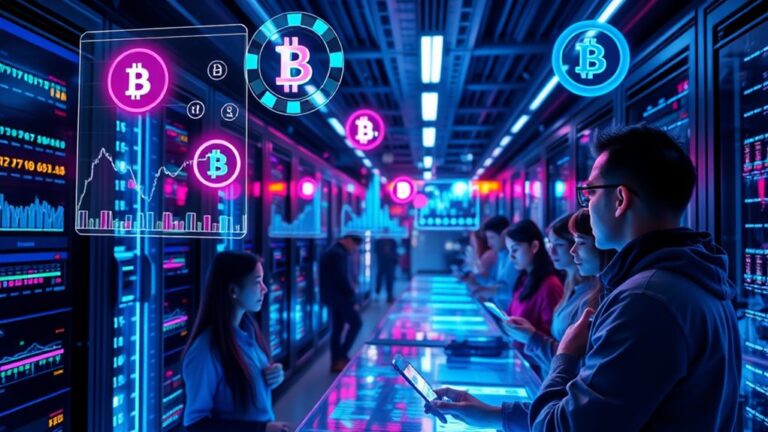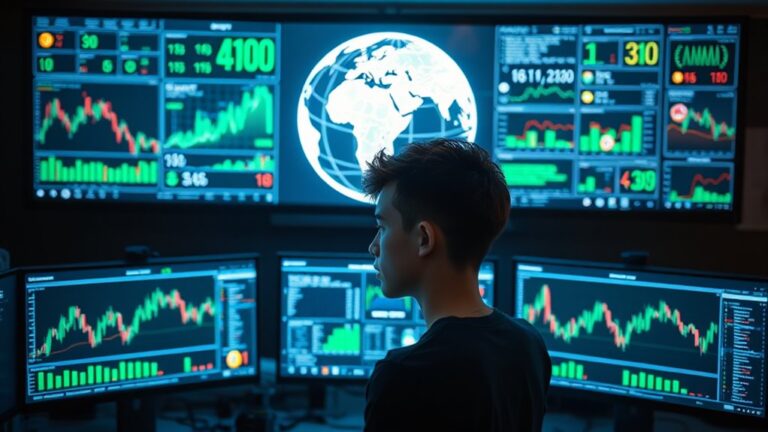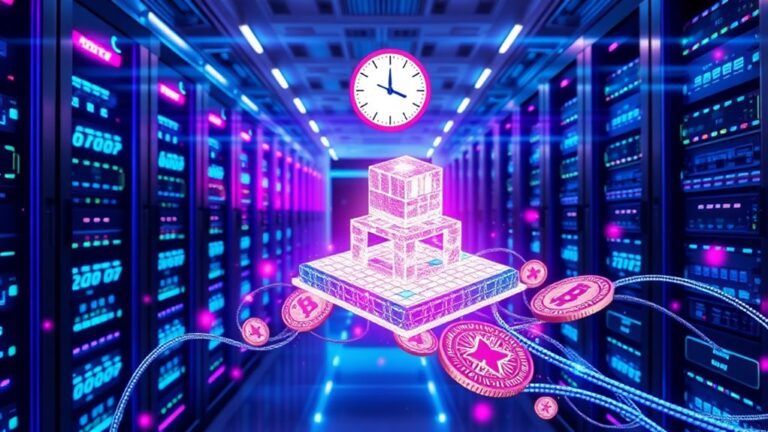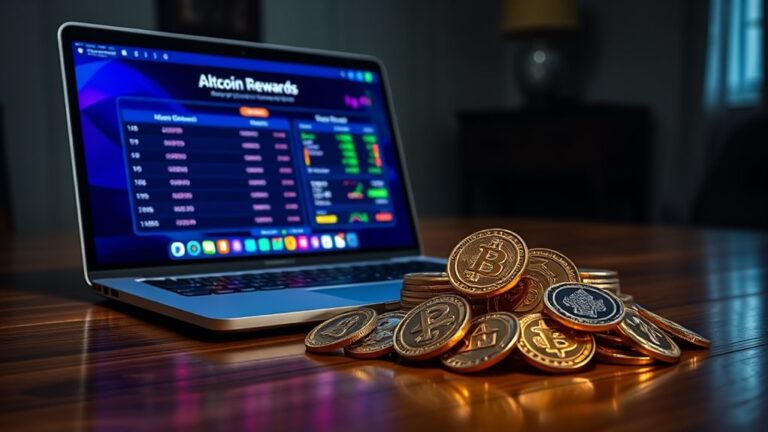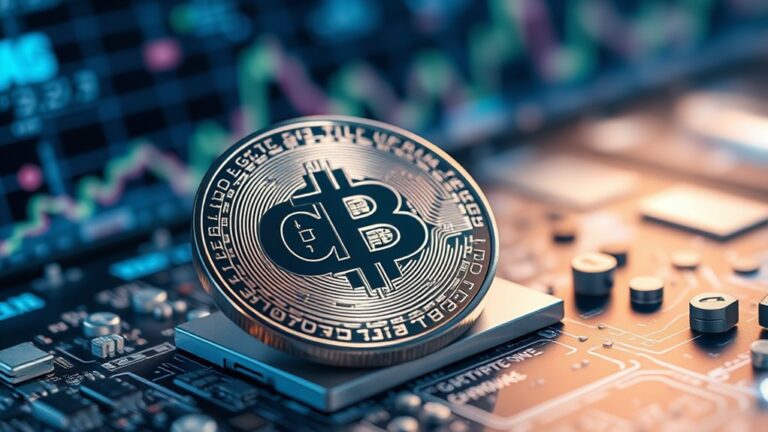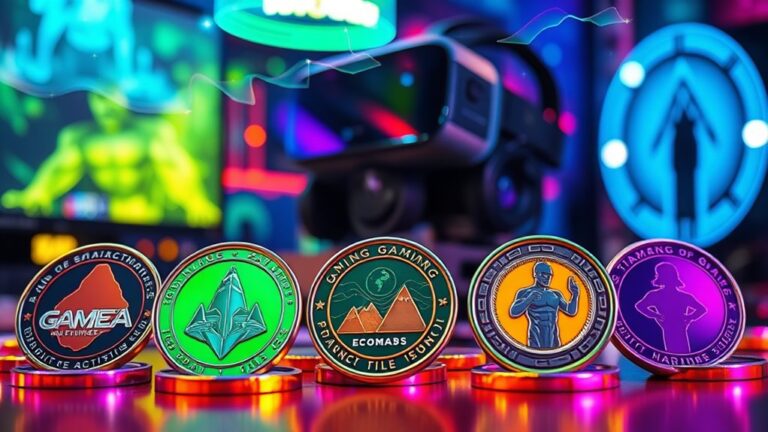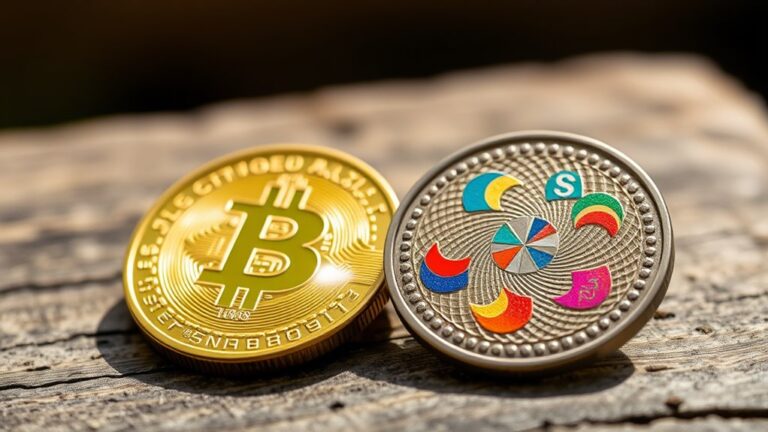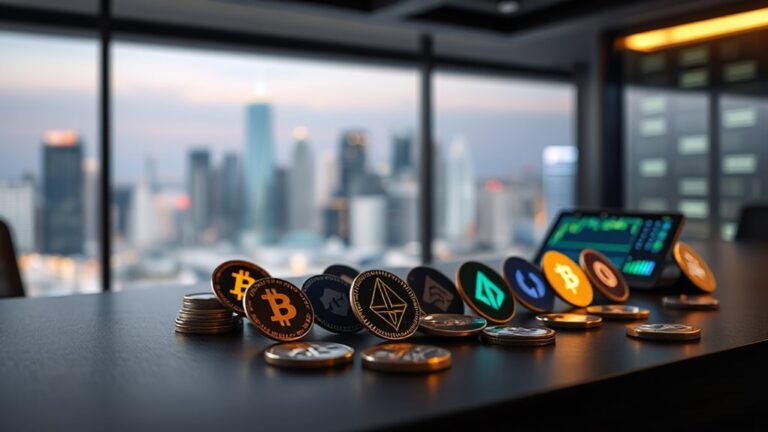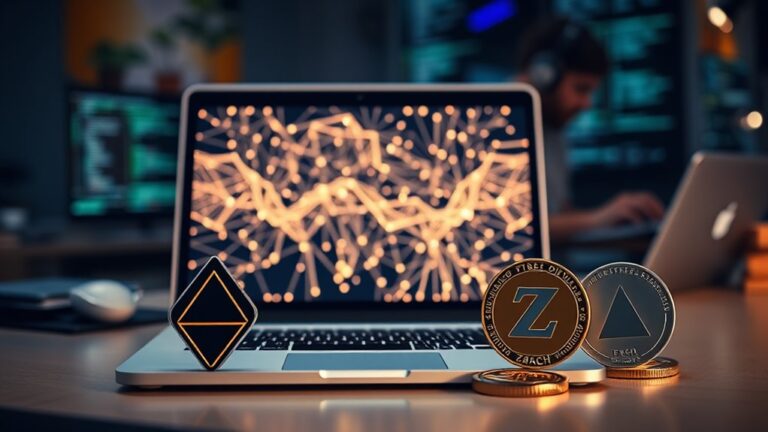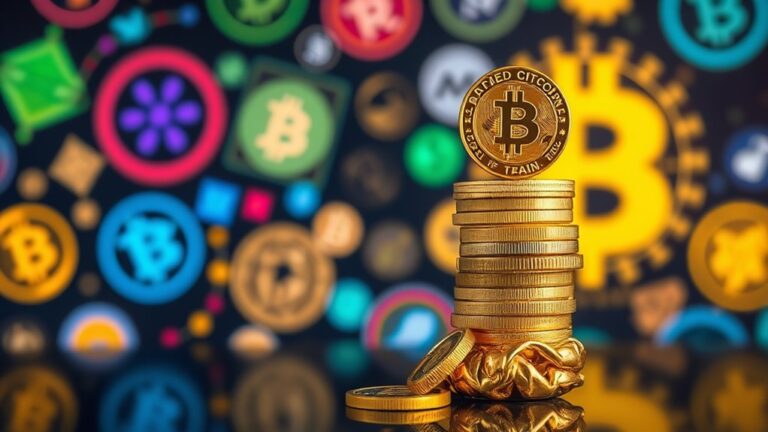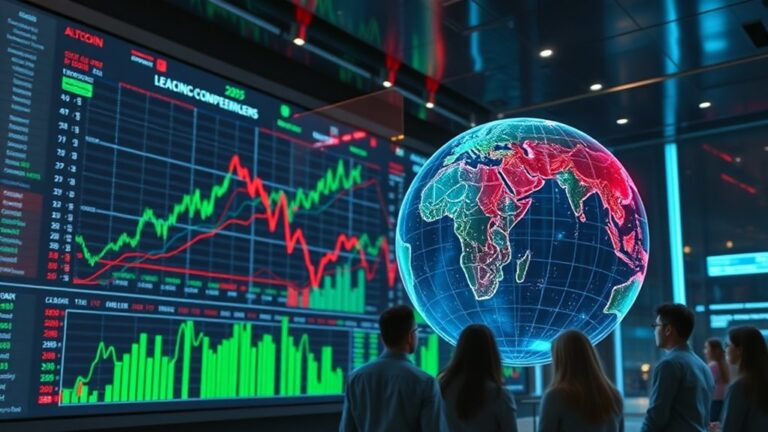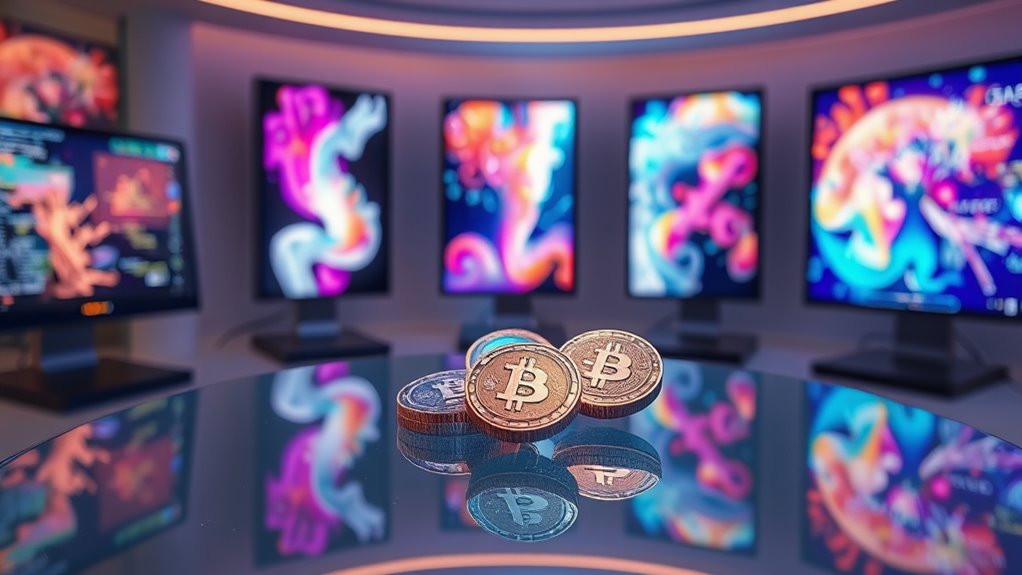
Top NFT-Related Tokens: What You Need to Know
Top NFT-related tokens like Enjin Coin, SAND, AXS, and OMI play significant roles in the blockchain ecosystem. Enjin Coin enhances in-game asset ownership, while SAND is essential for transactions in The Sandbox metaverse. AXS enables governance in Axie Infinity, and OMI supports digital collectible trading on VeVe. These tokens promote player ownership, governance, and innovation, influencing market value and utility. Discover how these factors contribute to the evolving NFT landscape.
Key Takeaways
- Enjin Coin (ENJ) supports NFT integration in gaming, enhancing player ownership and in-game item transferability.
- SAND token is used for transactions, governance, and digital land purchases within The Sandbox ecosystem.
- Axie Infinity Shards (AXS) facilitate governance and incentivize participation through staking and Community Treasury management.
- OMI enables trading of digital collectibles on VeVe, with structured utility programs offering rewards and engagement perks.
- ERC-721 and ERC-1155 are essential standards for creating unique and complex NFTs on platforms like Ethereum.
An Overview of Key NFT-Related Tokens
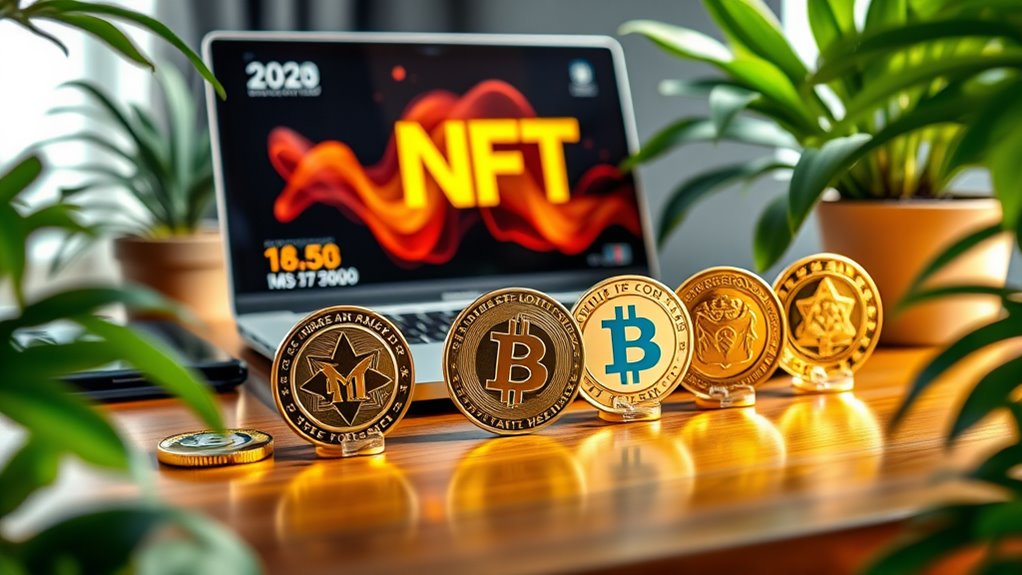
NFT-related tokens, representing a unique corner of the digital asset ecosystem, serve as the backbone of the entire NFT marketplace. NFTs, or Non-Fungible Tokens, are unique digital assets stored on blockchains, distinguished by their non-fungibility compared to regular cryptocurrencies. Utilizing blockchain technology guarantees secure storage and transaction transparency.
NFTs are unique digital assets on blockchains, ensuring secure storage and transaction transparency in the digital asset ecosystem.
Each NFT is marked by a distinctive identifier, typically managed through smart contracts, which provides proof of ownership for digital or real-world assets.
Several NFT standards and protocols have emerged, with ERC-721 being the most popular on Ethereum, defining non-fungible characteristics. ERC-1155 further advances by integrating both fungible and non-fungible tokens in a single contract.
Meanwhile, blockchains like Flow and Polygon support NFTs, focusing on gaming applications and scalability, respectively.
Exploring Enjin Coin's Role in Gaming
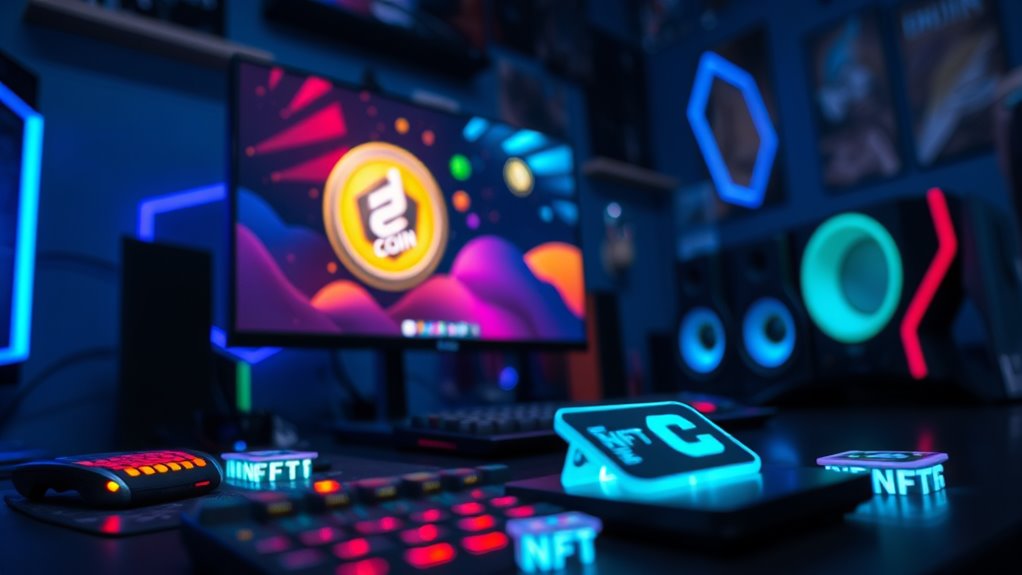
Building on the understanding of NFT-related tokens, Enjin Coin (ENJ) stands out in the domain of blockchain gaming, offering a robust solution for integrating NFTs into game ecosystems. Enjin's platform is designed to facilitate the creation and integration of NFTs seamlessly, supporting a wide variety of decentralized applications (DApps), games, and web3 platforms. ENJ empowers game developers by tokenizing in-game items, ensuring secure ownership and easy transfer. This tokenization improves player engagement through rewards and incentives. The Enjin marketplace hosts numerous gaming-related NFTs, allowing users to trade collectibles and assets. Enjin's compatibility with Ethereum and solutions like JumpNet enhances transaction efficiency. Additionally, ENJ's role extends to minting NFTs, thereby maintaining consistent valuation and ensuring proof of ownership. As the metaverse evolves, digital ownership becomes increasingly significant, underscoring the potential impact of blockchain-based tokenization on diverse virtual ecosystems.
Understanding the Power of SAND in The Sandbox
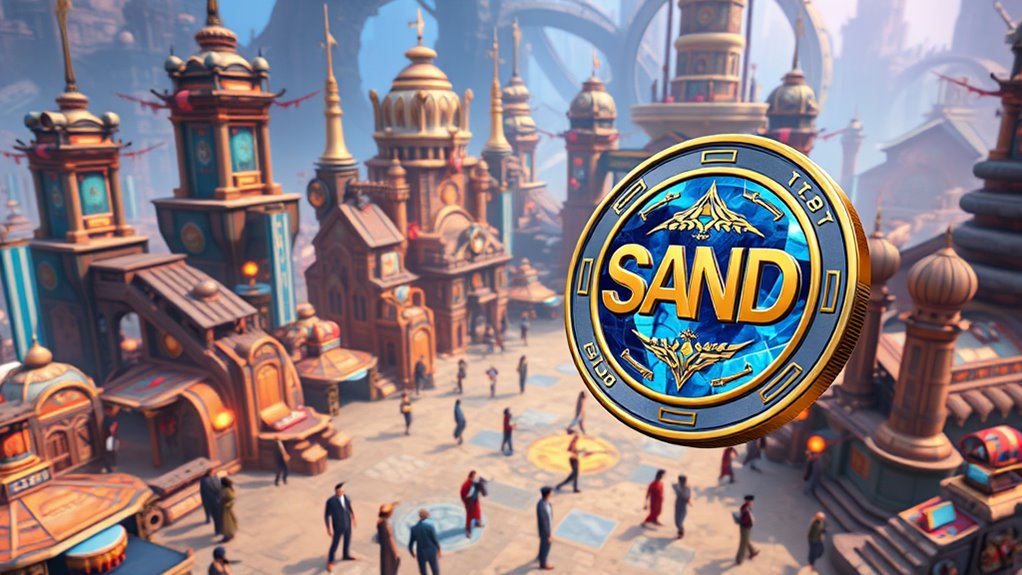
The Sandbox, a dynamic virtual world on the blockchain, is transforming how users interact with digital assets and experiences. Central to this ecosystem is the SAND token, an integral utility token facilitating transactions, governance, and digital land purchases. Operated on the Ethereum blockchain and capped at 3 billion tokens, SAND's value is underpinned by its scarcity. Users employ SAND for buying "LAND", creating and trading NFTs, and developing interactive games. The platform's features, such as the Voxel Editor and Game Maker, allow creative freedom and monetization opportunities, encouraging user investment as The Sandbox grows.
| Feature | Description |
|---|---|
| SAND Usage | Transactions, NFT creation, game development |
| Total Supply | 3 billion tokens, ensuring scarcity |
| Governance | Participation via decentralized autonomous organization (DAO) |
| Platform Tools | Voxel Editor, Game Maker, Marketplace for asset trading |
Governance and AXS in Axie Infinity
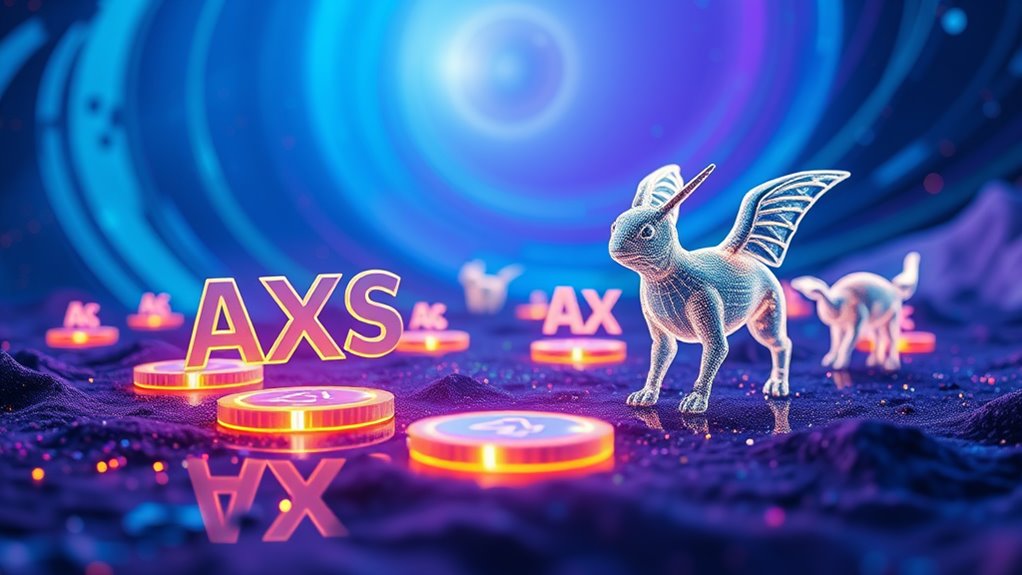
Axie Infinity's governance system is anchored by Axie Infinity Shards (AXS), functioning as a pivotal tool for decentralized decision-making. AXS, an ERC-20 governance token, empowers its holders with voting rights to shape the game's future development. Totaling only 270 million, AXS tokens prioritize aligning player and developer incentives for true decentralization. Token holders influence key governance decisions, manage the Community Treasury, and show support for proposals. This decentralized framework bolsters community involvement in Axie Infinity's evolution. For staking, participants receive rewards, fostering long-term participation via issuance of newly minted AXS. Holders engage in governance akin to a governance token's utility, enabling them to contribute to platform development and protocol changes. Despite its volatile market nature, with a significant decline from its peak market capitalization, AXS remains a vibrant entity within the NFT space, enticing ongoing player engagement.
The Importance of OMI in VeVe's Digital Collectibles
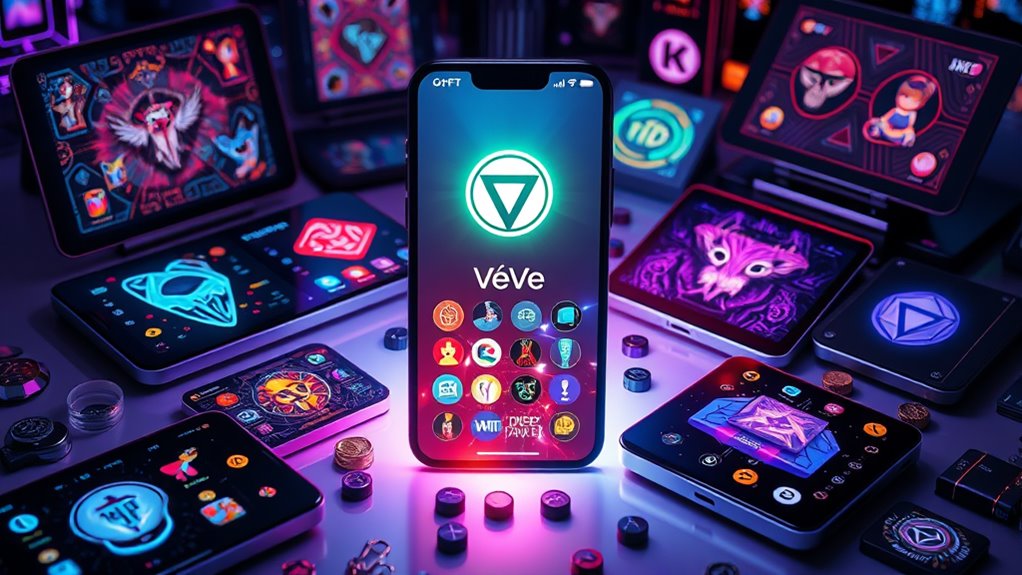
OMI serves as the native token within the ECOMI and VeVe ecosystems, essential for enhancing the digital collectibles experience. This token facilitates trading digital collectibles on the VeVe platform, while also maintaining transparent ownership records. Central to VeVe's utility program, OMI offers rewards and perks, influencing the expanding digital collectibles market. A structured reward system categorized into OMI Reward Tiers encourages engagement, and OMI can be used for MCP Tickets, supporting app benefits like fast-tracked level progression. This emphasis on utility and rewards aligns seamlessly with VeVe's future OMI advancements.
| Feature | Role of OMI Token | Benefit |
|---|---|---|
| Transaction Medium | Facilitates trading and purchasing | Secure and efficient trading |
| Reward Program | Central to VeVe's utility and MCP programs | Earns rewards and MCP Points |
| Ownership Records | Transparent record of transactions | Secure digital asset ownership |
Scalability and Gas-Free Transactions With IMX
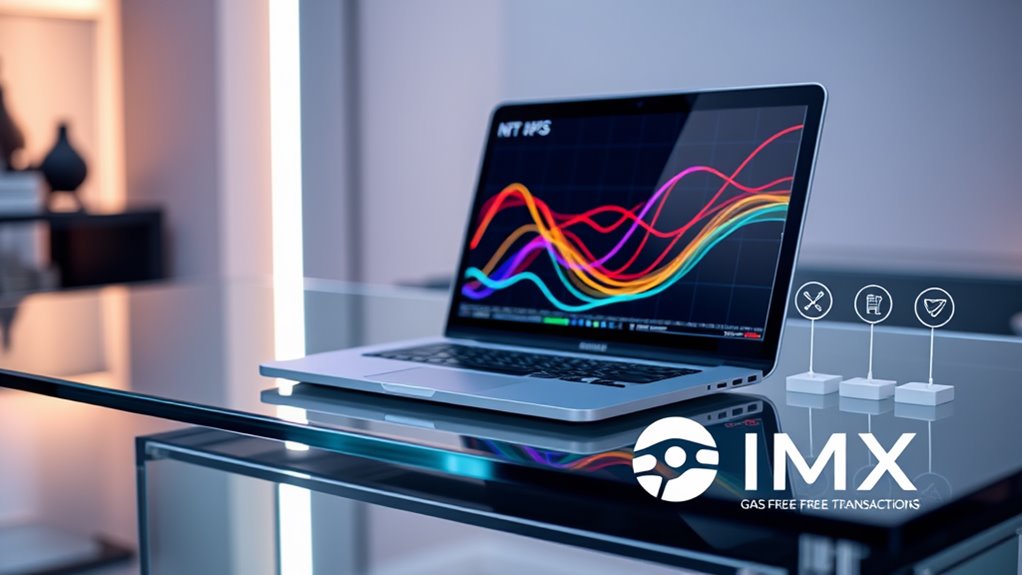
While tackling the challenges of scalability in blockchain technology, Immutable X (IMX) emerges as a pivotal solution, particularly for NFT transactions.
As a Layer-2 solution on Ethereum, IMX primarily addresses scalability and high transaction fees associated with NFTs. It employs Zero-Knowledge Rollups (zk-Rollups) to batch transactions efficiently. This approach allows IMX to process approximately 9,000 transactions per second without the congestion found on Ethereum's mainnet.
Additionally, users enjoy a near gas-free experience, greatly enhancing the transaction process.
Enjoy seamless NFT transactions with IMX thanks to its nearly gas-free experience.
- Gas-Free Transactions: IMX covers gas costs internally, providing a near gas-free experience.
- ZK-Rollup Technology: Efficient batching reduces congestion and improves speed.
- Carbon Neutrality: IMX claims to offset its carbon footprint.
- Fast Confirmations: Offers instant confirmations, enriching user experience.
Gaming Applications and NFT Utilities
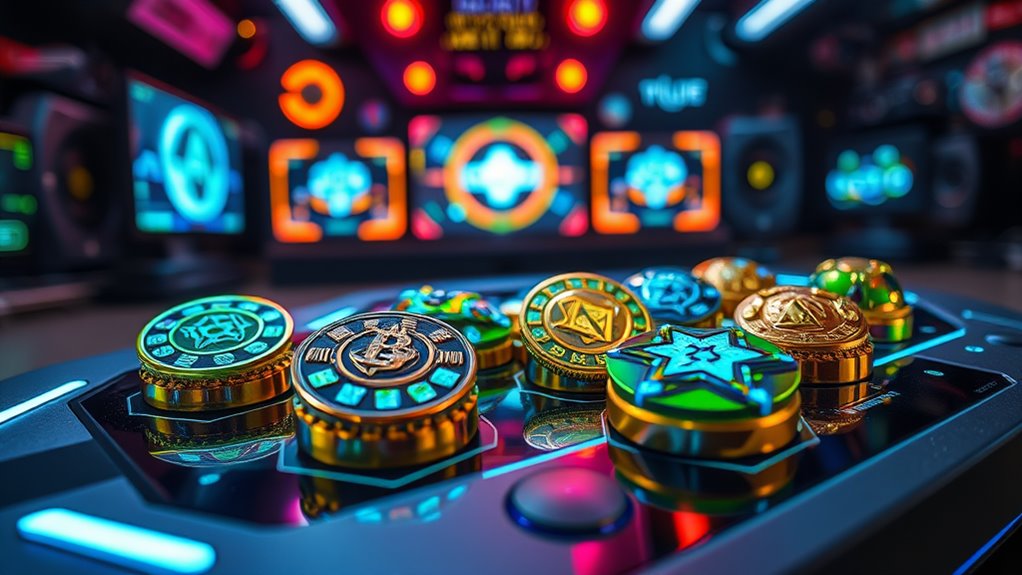
In the domain of gaming, NFTs enhance player involvement by integrating governance roles, allowing users to have a say in game development through votes on proposed changes. Utility-driven digital assets improve the gameplay experience, facilitating character customization, and offering access to exclusive in-game content or virtual spaces. Additionally, the intersection of decentralized finance (DeFi) and gaming is realized as players engage in economic transactions, using NFTs as a bridge for financial interactions, exchanging, and earning real value within virtual worlds. With the rise of the metaverse, there is a growing interest in metaverse-focused cryptocurrencies which power virtual economies, providing a promising investment opportunity in the evolving game and virtual world landscape.
Governance in NFT Gaming
Governance in NFT gaming represents a revolutionary shift where players and token holders participate in game development through decentralized decision-making processes. This approach, relying heavily on blockchain technology, integrates DAOs to empower players by giving them a voice in vital game development decisions.
Smart contracts automate these processes, bringing transparency and efficiency to governance. Community building, often through platforms like Discord, enhances engagement and fosters a sense of ownership among players.
- Decentralized Governance: Involves players directly in game progress.
- Smart Contracts: They streamline and automate voting mechanisms.
- Player Empowerment: Boosts user engagement and collaboration.
- Community Building: Encourages active participation and communication.
These governance methods help maintain security, fairness, and innovation across NFT gaming platforms.
Utility-Driven Digital Assets
Utility-driven digital assets, particularly utility NFTs, are transforming the landscape of digital ownership by offering unique functionalities beyond mere possession. Operating on blockchain technology, they provide secure and transparent ownership through smart contracts.
Utility NFTs hold extended value by deriving practical applications, distinguishing them from traditional, aesthetic-driven NFTs. They possess dynamic attributes that can adapt to conditions and are interoperable, enhancing their versatility across decentralized applications (DApps).
In gaming, utility NFTs serve as in-game assets with functional roles, allowing players genuine ownership, trade, and interaction on multiple platforms. They contribute to vibrant virtual economies and are pivotal in play-to-earn models.
These NFTs extend into real-world uses, providing event access, tokenizing physical assets, and enabling governance in decentralized organizations.
DeFi and Gaming Integration
Expanding upon the innovative capabilities of utility-driven digital assets, the convergence of decentralized finance (DeFi) and gaming is reshaping how digital ownership is perceived. This integration allows players to own their in-game NFT assets and engage in decentralized governance through blockchain technology.
The presence of smart contracts guarantees asset security and transparent transactions, creating a robust foundation for gaming ecosystems.
- NFT Liquidity and Collateral: DeFi protocols provide liquidity pools and allow NFTs to serve as collateral for loans.
- Active In-Game Economy: Players can stake and engage in yield farming with in-game assets, encouraging active participation.
- Cross-Platform and Cross-Chain Use: NFTs function across diverse platforms, bridging GameFi and DeFi ecosystems.
- Greener Blockchain Practices: The focus is also shifting towards environmentally friendly blockchain technology.
NFTs have also been connected to digital art and collectibles, offering artists new ways to monetize their work and participate in secondary sales, which can be especially lucrative with the integration of royalty systems.
Market Trends and Performance of NFT Tokens
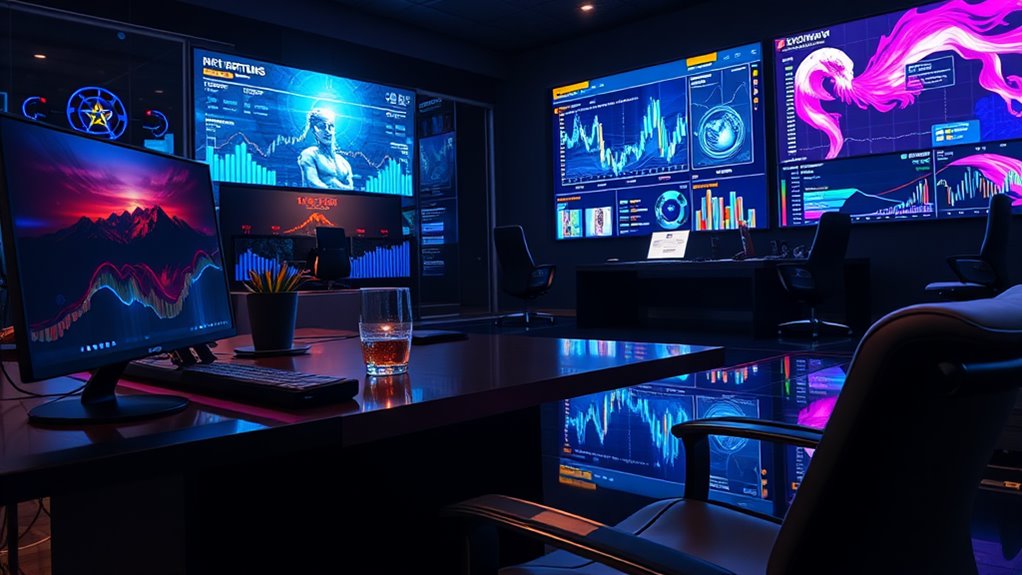
The NFT market is witnessing significant growth in adoption, evidenced by rising user numbers and expanding blockchain options; however, token price volatility remains a notable challenge.
This fluctuation is often driven by market speculation, innovation in utility NFTs, and integration into industries such as music and gaming.
Despite these challenges, projections suggest a robust future for NFTs, with expected growth driven by increased mainstream acceptance and technological advancements.
Token Price Volatility
While the NFT market continues to expand and capture global attention, its token price volatility remains a defining characteristic that sets it apart from more traditional financial markets. The NFT market experiences higher volatility, with weekly fluctuations outpacing those seen in stocks or general cryptocurrencies. Fluctuations often follow heavy-tailed probability distributions, illustrating notable variations in price metrics.
- Market Conditions: Economic and technological shifts notably impact NFT volatility.
- Technological Integration: Innovations such as dynamic NFTs and cross-chain technologies add complexity to market behavior.
- Utility NFTs: These can potentially lower long-term volatility by adding tangible ownership benefits.
- Regulatory Influence: New regulations could stabilize the market by offering clarity to stakeholders.
Understanding these factors helps in grasping NFT token price volatility.
Growth in Adoption
As NFTs continue to attract attention, the growth in their adoption highlights notable market trends and the performance of NFT tokens. The expanding global NFT user base, expected to reach 11.6 million by 2025, underscores increasing interest. Market projections estimate a significant growth to a $61 billion size by 2025. Mainstream acceptance is fueled by real-world applications, while blockchain advancements enhance security and transparency. Cross-chain compatibility is also pivotal, improving NFT trading accessibility across different networks. In parallel, new trends emerge with Bitcoin and hybrid NFTs broadening the ecosystem. Additionally, utility NFTs enrich experience and ownership. The table below showcases key elements driving NFT growth:
| Aspect | Trend/Impact | Example |
|---|---|---|
| Market Growth | Increasing User Base | 11.6 million users by 2025 |
| Market Growth | Market Expansion | $61 billion by 2025 |
| Industry Adoption | Mainstream Acceptance | Real-world applications |
| Blockchain Advancements | Security & Transparency | Continued innovation |
| Trading Evolution | Cross-Chain Compatibility | Enhanced accessibility |
Technological Infrastructure and Standards
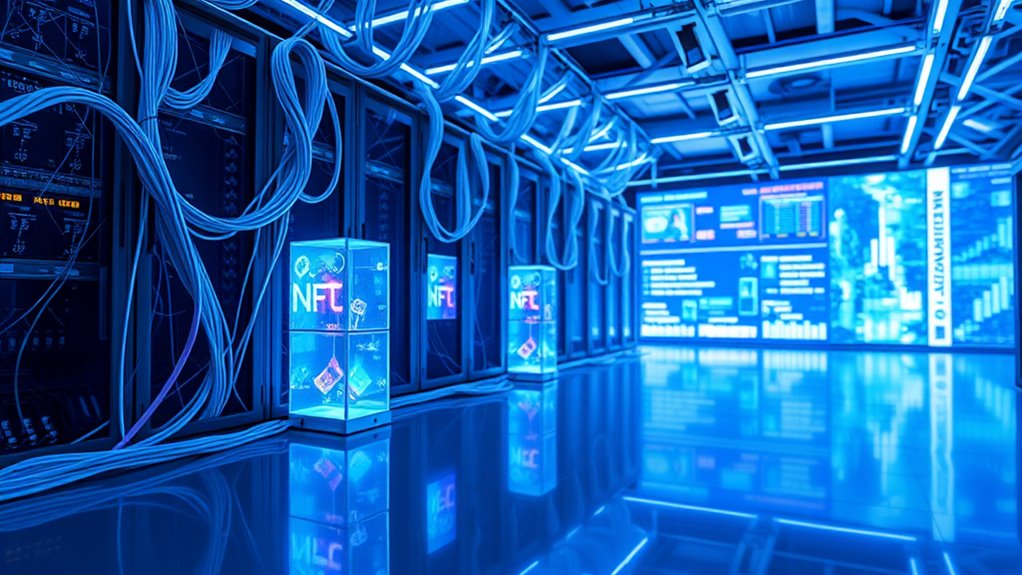
Although technological infrastructure for NFTs continues to evolve rapidly, blockchain platforms such as Ethereum, Solana, and Polygon remain the backbone due to their smart contract capabilities and varied transaction speeds.
These platforms enable decentralized ledgers offering transparency and security. Smart contracts automate transactions and allow for detailed ownership verification, integrating features like royalties.
The interoperability of NFTs across platforms encourages wider usage and liquidity in different marketplaces. Despite concerns over environmental impact, proof-of-stake blockchains are explored for sustainability.
- ERC-721 and ERC-1155: NFT standards facilitating unique and complex asset creation.
- Smart Contracts: Automate transactions, verifying ownership and enabling dynamic content.
- Security: Includes wallet protection and safeguarding against phishing.
- Environmental Solutions: Shift to energy-efficient blockchains like proof-of-stake.
The Proof-of-Stake consensus mechanism is a pivotal environmental solution, requiring less energy than the traditional proof-of-work model, as exemplified by Ethereum's transition with "The Merge."
Current and Emerging NFT Projects
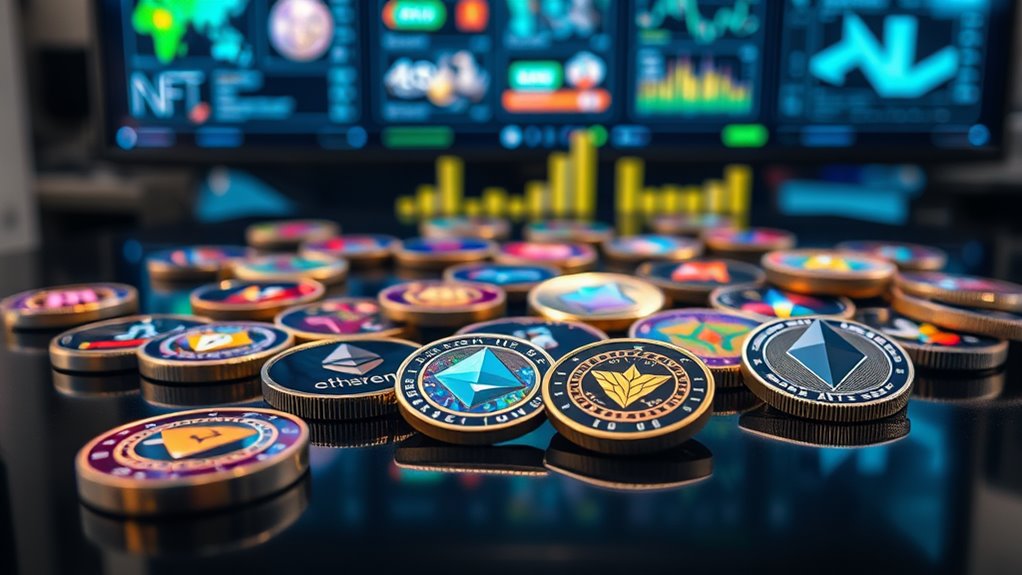
The landscape of current and emerging NFT projects is showcasing a transformative phase where digital assets are evolving beyond simple collectible items into utility-driven tools.
Changes include the integration of NFTs with gaming and decentralized finance (DeFi), enhancing functionality across various blockchains. For example, projects like Loaded Lions have successfully adapted into multi-chain platforms focused on governance and gaming, while Bitcoin NFTs expand the ecosystem, leveraging Bitcoin's robust security.
Strong community support, as seen with Bored Ape Yacht Club and CryptoPunks, remains essential for success. Additionally, platforms like Solana Monkey Business emphasize the profitability within specific ecosystems.
Frequently Asked Questions
What Are the Tax Implications of Owning Nft-Related Tokens?
Tax implications for NFT-related tokens include treating them as property, triggering taxable events upon selling or trading, with gains taxed as ordinary income or capital gains, depending on holding periods. Accurate reporting and documentation are essential for compliance.
How Do NFT Tokens Impact Environmental Sustainability?
NFT tokens impact environmental sustainability through significant energy consumption and carbon emissions from blockchain operations. Shifting to energy-efficient alternatives, like Proof of Stake and using renewable energy sources, can mitigate these environmental concerns.
Can NFT Tokens Be Insured Against Loss or Theft?
NFT tokens can be insured against loss or theft through specialized insurance products, such as cyber liability insurance and insurtech solutions. However, challenges persist due to fluctuating values, theft vulnerabilities, and evolving regulatory frameworks affecting coverage availability.
What Security Measures Should NFT Investors Consider?
NFT investors should consider using hardware wallets and two-factor authentication to secure assets. Regularly updating wallet software, securely storing seed phrases offline, and diversifying investments can mitigate risks associated with unauthorized access and market volatility.
How Do Legal Regulations Impact Nft-Related Token Transactions?
Although steering through intricate regulations might seem intimidating, understanding how legal requirements impact NFT transactions is essential. Legal regulations determine tax obligations, compliance with securities laws, and influence cybersecurity risks, consequently affecting both investors and creators considerably.
Conclusion
NFT-related tokens are the beating heart of the digital asset space, offering unique utilities across diverse platforms. From Enjin Coin's presence in gaming to the governance role of AXS in Axie Infinity, these tokens shape the landscape of virtual economies. As market trends and technological developments continue to evolve, these tokens stand at the forefront, defining the future of NFTs. With their versatile applications, they remain integral to ongoing and emerging NFT projects.

